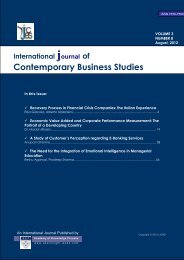Contemporary Business Studies - Academy of Knowledge Process ...
Contemporary Business Studies - Academy of Knowledge Process ...
Contemporary Business Studies - Academy of Knowledge Process ...
Create successful ePaper yourself
Turn your PDF publications into a flip-book with our unique Google optimized e-Paper software.
International Journal <strong>of</strong> <strong>Contemporary</strong> <strong>Business</strong> <strong>Studies</strong>Vol: 4, No: 2. February, 2013 ISSN 2156-7506Available online at http://www.akpinsight.webs.comMarket segmentation is a concept that interests both customer as well as marketers. It is to treat them likethey are alike and most will be less than well satisfied. This is the trend today. Thirty years ago marketerswere crazy about mass marketing. The rationale behind mass marketing included the level you achieve inboth manufacturing and communication by reaching a large group <strong>of</strong> people with the same product andmessage. In recent years, however, marketers found that if the mass market was divided into smallersegments yet similar groups these smaller segments could be better satisfied.If you target customers basedon the similarity <strong>of</strong> the benefits that meet their needs, you will have more chances to win their satisfactionand market product easily. So now we get back to the rationale <strong>of</strong> market segmentation: it is easier tosatisfy a smaller group than a larger group. Anything that we can do is in turn to satisfy people better andis <strong>of</strong> direct benefit to our organization(Kotler, 2007).The smaller and less heterogeneous the group is, the easier it is to satisfy people in the group. That makesperfect sense because a group <strong>of</strong> ten is generally more homogeneous than a group <strong>of</strong> 1,000. The concept<strong>of</strong> viable segments shows us how an organization is capable <strong>of</strong> satisfying large groups and captures themarket. Let’s take an example <strong>of</strong> garments or cloth (Homburg et al., 2012).Imagine no segmentation whatsoever exists. The result would be that we would have one garment foreveryone in the world without any considerations <strong>of</strong> size, gender, color, style, etc. We know immediatelythat the price would be low because <strong>of</strong> economies <strong>of</strong> scale in production and distribution. But we alsoknow that satisfaction would be minimal. It is almost impossible to satisfy everyone. Some wouldn't likethe color or style.On the other hand let’s assume the ultimate in segmentation: products designed for each individual. Youpick the cloth; discuss the style for stitching; color that you like and which suits on you; size that fits toyour body etc. You know immediately that you would love it - after all, it would be designed for youindividually. But we also know that it would be so expensive that we might possibly not afford it. Thebest is to fall somewhere in between these two extremes(Füller & Matzler, 2008).Practically, segments must meet three criteria: they must be identifiable, reachable, and affordable.Meaning how small can a segment be and still be worth targeting?First identify the individuals in a group on the basis <strong>of</strong> some common characteristics that they possess. Itcould be a demographic variable (Age, Gender, Income etc). It could be a psychographic variable(Activities, Interests, or opinions etc). It could be geographic (Based on location or climatic factors). Or,to make things really interesting and generic it could be some combination <strong>of</strong> these (Females, Age 20-30,with high incomes who are into fashion and styling, interested in shopping and who live in the samecity)(Füller & Matzler, 2008).You have to target these groups with some preparation to promote or market your product/activity withproper communication that they would like. You have to be able to produce an <strong>of</strong>fer for product orservice the group want and can pay reasonable price for it. This will definitely vary a lot amongst groups.Because this concept <strong>of</strong> market segmentation is based on qualitative measure <strong>of</strong> interests and needs. Price<strong>of</strong> a product varies as per the basic economic concept <strong>of</strong> demand and supply. If demand is greater thansupply, price can be high. If it isn't high, there will be a waiting list (Füller & Matzler, 2008).6.SIGNIFICANCE OF STUDY1. Facilitates concept <strong>of</strong> effective product strategy: Due to market segmentation, productdevelopment is well suited with consumer needs. This is because there is clear understandingthat if organization introduce product for specific customer group and target specific market.Market segmentation encourages the close matching. Eventually it gives satisfaction toconsumers and higher sales and pr<strong>of</strong>it (Hultman, Robson, & Katsikeas, 2009).2013©<strong>Academy</strong> <strong>of</strong> <strong>Knowledge</strong> <strong>Process</strong>47
















